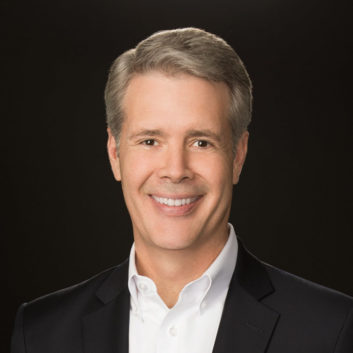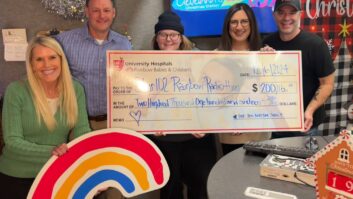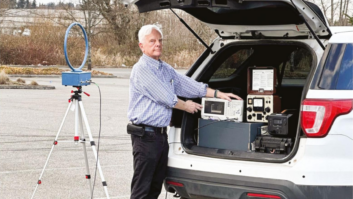 When communications attorney Robert McDowell started feeling a little under the weather last month, he chalked it up to seasonal allergies and related bronchitis and got the usual antibiotic from his primary care physician. Then his symptoms worsened.
When communications attorney Robert McDowell started feeling a little under the weather last month, he chalked it up to seasonal allergies and related bronchitis and got the usual antibiotic from his primary care physician. Then his symptoms worsened.
It wasn’t seasonal allergies.
After a trip to the hospital and back home again, the former FCC commissioner was readmitted with what turned out to be COVID-19-related double pneumonia.
Throughout the arc of his escalating illness he was tweeting occasional status reports that had his many friends in Washington communications circles concerned, then emailing each other with many questions and no answers as his tweets stopped for several days. His silence was understandable in retrospect.
Still regaining his strength (he lost 12 pounds during the ordeal) and with a slight cough and what he calls a “shipwreck survivor” beard — he declined to provide photographic evidence — a gratefully recovering McDowell talked with Radio World’s sister publication Multichannel News in an exclusive interview on those harrowing times and how he eventually made it home.
In a scene straight out of a Hallmark movie, that homecoming was marked by a double rainbow (see photo), a return he credits to the prayers and support of his friends, timely Facetime telemedicine from a lifesaving doctor outside the hospital, continuity of care from another lifesaving doctor inside the hospital, and some serious self-advocacy.
Multichannel News: When did you first notice symptoms?
McDowell: It was March 14. I felt like I had my usual allergy-induced bronchitis, which I get every couple of years. I called my doctor and she put me on Azithromycin [an antibiotic] as usual. I took the normal cold decongestants.
MCN: Walk us through how this escalated from “Oh, this is seasonal allergies” to making burial arrangements.
McDowell: I felt OK, like I had bronchitis, but I was totally functional March 14 and 15. On March 16 or 17 I sprouted a mild fever, which, again, isn’t unusual when I have bronchitis. But in the back of my mind I was thinking: “I’ve been on antibiotics for three days. This shouldn’t be happening if I am on antibiotics.” But other than that I felt fine, though a little bit slowed down.
On the 17th, St. Patrick’s Day, my son reported that his friend, who had been a houseguest of ours March 6–8, had tested positive for COVID. I was grateful to him for getting tested and letting us know. He deserves a gold medal for that.
MCN: And then the light began to dawn?
McDowell: That prompted me to call my doctor, Dr. Connie Le. She’s fantastic and a hero in this whole story, big time. She saved my life.
She had me come in — it is now March 18 — and they arranged, after a lot of work over a few hours, to get me tested at an Arlington County Health Department drive-through COVID testing center. [Arlington is one of the Virginia counties with the highest incidence of COVID-19.] It was very difficult to get. It was their first day of operation. I got a throat swab like you get for a strep test.
I got more congested and an increased cough, so I Facetimed Dr. Le on March 20 — at this point we were only seeing each other via Facetime — and she saw something she didn’t like.
MCN: So, this clearly demonstrates the value of telemedicine and connectivity?
McDowell: Yes, this was the mobile internet. Thank goodness for all those spectrum auctions I helped promote.
So, Dr. Le sees something she doesn’t like on Facetime and says: “You’ve got to go to the ER.” I protested, saying “Look, I feel fine. I just have an increased cough and increased congestion.” But during the week my temperature had been starting to yo-yo from normal to 103, then back down to 99 and then 101.5, then normal again.
MCN: Were you thinking COVID-19 yet?
McDowell: Yes, but I’m thinking I don’t need hospitalization. I’m a healthy 56-year-old, I go to the gym. I run, I don’t have any of those compromising conditions. So, technically I guess I was in denial. But thankfully my doctor had an amazing ability to perceive something over Facetime. There was nothing obvious that I knew, but she saw something. Maybe it was a sixth sense.
MCN: Did she tell you what she saw?
McDowell: I didn’t ask her to try and deconstruct it because I didn’t want to bug her. I knew she had a lot of other patients. I will someday, though.
She sent me to the ER just before midnight Friday night the 20th. They took a chest X-ray and found a spot of pneumonia in my left lung. I have never had pneumonia before. And, that’s kind of serious, so you’re thinking: “I’ve got COVID-related pneumonia.” Remember I’m still not officially diagnosed because the test results aren’t back [they would ultimately confirm it was the virus]. The hospital gave me their own COVID test at that point.
So, they put me in a normal hospital room. I was not yet getting oxygen at this point.
On Sunday, March 22, the doctor in charge, they are called “hospitalists,” who I never saw or met and who did not examine me — he was keeping track of my numbers, my blood oxygen saturation level, heart rate and blood pressure —– discharged me. I was happy with that, so I didn’t resist and went home.
On Monday, March 23, I was coughing more and still having a lot of congestion. Dr. Le kept asking me [again via Facetime] if I felt short of breath. I said, “Well, I have pneumonia so there are times when I feel a little winded, but I am coughing, too, a lot, so what’s the difference?” She again saw something she REALLY didn’t like this time and so she called 911. She didn’t tell me or ask me. She just did it, then called my wife to say “be ready in two minutes.”
The amazing Fairfax County EMTs came in all their protective gear, absolutely fabulous, and put me on oxygen right away. I felt better right away. It’s amazing what a little oxygen can do. And off I go to the ER again. They take X-rays again, and I have full-blown double pneumonia and my lungs are filling with fluid. Meantime, the doctor tells my wife that I have less than a 50% chance of survival.
MCN: And did you feel like someone with less than a 50% chance of survival?
McDowell: I didn’t feel like a dying man. Thankfully I remained conscious and had my wits about me. Jennifer, my wife, probably knew more about my condition than I did at that point. But in the ER, I could see very grim looks on the faces of the doctors. There was an older doctor, a guy who had been an ER doctor his entire career and you could tell he had seen it all, and he kind of kept looking at me out of the corner of his eye as though he didn’t like what he saw, either. Then another pulmonologist came in who was very alarmed when she saw that I was on five liters of oxygen. The more oxygen you need, the less well your lungs are functioning as they should to transfer oxygen to your bloodstream.
This is where self-advocacy came into play.
MCN: Did they bring up the possibility of intubation.
McDowell: Yes, after I was out of the ER and up in my room. But while I was still in the ER, and to give you some background, in 1992 I was kicked by my horse and severely injured, rupturing my kidneys, liver and a lung. That put a hole in my lung. This is where I learned, when I was in intensive care back in 1992, that the interplay between your blood oxygen level and the amount of oxygen they are feeding you is a very key indicator of whether or not they are going to intubate you or not.
So, while I was still in the ER, I convinced the doctors to turn down my oxygen because nobody took ownership as to why I was at five liters. I said, “Well, turn me down to three and see what happens. If I turn blue, you can turn it back up,” which you can do in a second in the ER. I said I am going to try some meditation and prayer and see if I can try to keep it above 90%. It was a gamble. At first they resisted because I think I was in such a nosedive they didn’t want to take any chances. But I think I was sentient enough, and said it in a constructive, collaborative way — I wasn’t glowering at them — that they tried it. I never needed to go back up to 5 liters again, because my blood oxygen level remained above 90% [with one brief exception noted below].
To get back to your question, eventually I get to the hospital room. It’s a sealed room where you are all by yourself, right. Nobody is allowed in. Your primary care doctor is not allowed in the building. Family is not allowed in the building. I would advise people to bring your [phone] power cord so you can stay in touch.
They asked would you prefer Jello or broth? I said, “Well, I can’t have either because they are both full of MSG and I get migraines from MSG. How about something to eat like just grilled fish.” They said, “No, we need to keep you on a clear diet.” Why do you need to keep me on a clear diet? “Because the doctor is preparing to intubate you.”
That is how I found out. And that became a pivotal moment because I knew that if I was headed toward intubation, odds are — statistics are all over the place — but odds are I won’t be coming home.
MCN: How did you react?
McDowell: That was a moment for me to really kind of rally and keep my oxygen levels up. They were preparing to intubate me and preparing to wheel me up to the ICU. I think I was in a stepped-up, sort of intermediate level, not intensive care but not a regular room.
They had this sort of SWAT team of registered nurses who walked around with backpacks. I don’t know if they were defibrillators or oxygen. But once, when my blood oxygen dipped into the 80s, this big burly guy with a backpack shows up at my doorway to check on me. We had a pleasant conversation and I got my oxygen level back up then, so he was able to go away.
MCN: You said on Facebook you got the antimalaria drug that has been much in the news?
McDowell: Dr. Le was fighting for me to be put on hydroxychloroquine. The hospitalist, Dr. Borgschulte, was also seeing very positive results at the hospital when they administered the drug. I was all for it. They had not changed my medication from March 14 to March 23. I was in a nosedive. When I knew I was possibly going to be intubated, I was preparing my family for my demise and giving burial instructions. Keep in mind that my wife had been told I have a less than 50% chance of survival.
MCN: You had to do this over Facetime?
McDowell: Yes.
MCN: Not to give away the ending, but you got better.
McDowell: I think the hydrochloriquine was first administered on the 23rd. That was the only change. I had been on the same antibiotic, azithromycin, from the 14th to the 23rd, when I was given less than a 50% chance of survival. The antibiotic is meant to prevent a secondary bacterial infection. It doesn’t do anything with the virus.
MCN: What happened next?
McDowell: So, the next morning [the 24th], I woke to a very gentle yet strangely powerful finger on my forehead making the sign of the cross. So I said to the priest, “Hi, are you giving me the last rites?” He said “something like that.” It is unclear whether it was the last rites — the [Catholic] church doesn’t call it that anymore — but it was a step above the anointing of the sick. The day before I had asked for a priest, so it wasn’t completely out of the blue.
I also got a call from a priest at the Shrine of the Immaculate Conception in Washington. It turned out that former FCC commissioner Mike Copps’ wife, Beth, works there and Mike and Beth very sweetly had arranged for a priest from the shrine to call. That was incredibly thoughtful of them. Former commissioner Jonathan Adelstein also texted me to let me know he was praying for me in Hebrew.
But on the 24th, I pulled out of my nosedive and began to stabilize. I was no longer deteriorating, but I wasn’t gaining altitude either. That took a few days, which is why I was there until April 1.

MNC: You talked in a Facebook post about a rainbow.
McDowell: I came home April 1 and my son had to help me up one flight of stairs. I had to stop three times to catch my breath. We just rebuilt our house last year and there is this suite next to my office that my wife decided was perfect for COVID isolation. So, that evening near sunset I got a call — that’s how I communicate with my family — to look out my window.
There was a quality to the sunlight that was lighting up the trees in this brilliant, color-rich fashion that I hadn’t seen before. And they said, “Look. There’s a rainbow.” I had to kind of look out the window at a steep angle, and It was a double rainbow. So my son, Griffin, went outside and took a picture.
It was really nice to see that. People can say what they want, believe or not believe whatever they want about it, but it was rather remarkable. I’ve lived on this property for 56 years and I’ve never seen anything like that before. It was very inspirational.
MCN: So, how are you now [this interview was conducted April 8] and how long will you have to self-isolate?
McDowell: I checked with my doctor and I will have to stay a few more days in solitary confinement out of an abundance of caution. [McDowell coughed as though on cue.] I still have a persistent cough, which you can hear, and the doctor says it could take 10 or 12 weeks before I feel like myself again. I do go outside once a day to stroll around, and even jogged up a steep slope only 72 hours or so after having to stop three times to climb a flight of stairs. I had to prove it to myself. I was totally gassed and my heart was pounding, but I did it. I don’t do that every day. I’m not stupid. But I do walk around every day to pick up sticks and watch the birds and try to get the lungs expanded and the heart pumping.
And I am doing a little bit of work each day [McDowell is currently a partner and co-leader of Cooley LP’s global communications practice in Washington], reviewing documents and doing conference calls. I don’t have much stamina. I get very fatigued, but that is all apparently normal. We don’t know if I have permanent lung damage. It’s a possibility, but we won’t know for weeks or months.
MNC: Have you been tested again to see if you are negative?
McDowell: No, I have to do that at some point. I am not sure exactly how that works. But I have not been tested. I want the family to get tested for the antibodies, too, because I assume everybody has the antibodies, the five of us, since we had a houseguest who was contagious and the day I first came down with symptoms they were all around me.
MCN: You had tweeted in early March about traveling to New York and eating in a favorite restaurant amid the virus “panic.” In hindsight those tweets sound like you thought the virus might not be the threat it ultimately was. Was that the case?
McDowell: I was definitely taking all the precautions that were prescribed at the time [March 8]. So, I wasn’t shaking hands, social distancing, though I don’t think they were saying six feet at that point. I knew there was some risk going to New York. I don’t know if that’s where I caught it. I did have to go through Penn Station. But, yes, in hindsight I should not have gone to New York.
MCN: What would you say to anyone now who thinks that we are overreacting to the virus?
McDowell: We’re not.
MCN: Would you have any issue with the government using your personal info to build a COVID database or tracking your movements or others as part of a mitigation effort?
McDowell: I have already arranged for all of my relevant medical information to be used for studies. It depends on what they want, but I would be happy to provide all relevant information that could be helpful. And as soon as I am healthy enough I will be donating plasma in hopes that it can actually save somebody.
MCN: Do you have any advice from your experience, other than bring the power cord to the hospital?
McDowell: You don’t know how it is going to affect you if you are exposed to it. So, on paper this should not have affected me this way — a healthy 56-year-old with no underlying conditions. There is something about my makeup. Maybe it is the Type A blood. One theory is that males with Type A are hit harder by this and have a higher mortality rate. There is some evidence showing that.
It seems as if most people aren’t horribly affected by this. But there is enough data showing that it unexpectedly hits some people you wouldn’t expect to be so vulnerable really hard, and kills them.
My other advice is for people who are symptomatic. For me there were two “cliff” days. My doctor said that day seven, after the onset of symptoms, is a cliff day, meaning that if you are still sick and notice any degradation whatsoever, however slight, in your condition, on day seven go to the hospital. For me that was true. Then day 10 was another “cliff” day.
The point being is you can think you are just weathering a tough case of the flu for a week or more when in reality what’s happening is your lungs are filling up and you can end up in a tailspin all of a sudden.
Let me say one other thing. Knowing there were hundreds of people, maybe more, praying for me, people from all faiths, gave me a sense of comfort, resolve and strength. It was emotionally overpowering. People were texting me, direct-tweeting me, calling Jennifer. So I want to thank everyone, many people I don’t even know who they are. I felt like George Bailey in “It’s a Wonderful Life.”
MCN: What are you binge watching?
McDowell: I try not to, but I did binge watch some “Twilight Zone,” the original. We’re all living in it anyway.
Social (Media) Distancing
The arc of the virus and McDowell’s journey through it to a double rainbow on the other side was reflected in his tweets, beginning March 8.
One benefit to the asymmetric fear of #coronavirus: this is a great time to travel. I’m headed to #NewYork today for business (yes, the economy is still working: 273K new jobs in Feb.!) & there are no lines at the airport. Many #fearless people working though! pic.twitter.com/EZYa1soxFG
— Robert M. McDowell (@McDowellTweet) March 8, 2020
So there’s no way to sugar coat this: my doctor had me go to the ER last, and good thing. I have mild pneumonia due to likely #COVID19 infection. Docs are giving me IV antibiotics and the aim is to not remain here long. #CarpeDiem #GodBlessAmerica 🇺🇸 #Freedom
— Robert M. McDowell (@McDowellTweet) March 21, 2020
Update: after three brutal days battling pneumonia and likely #COVID19 in the hospital, I’m being discharged to go home into isolation. Thanks for the plethora of messages – too many to respond to. I’m still quite weak and will need my sleep. Please respect that. #GodBless
— Robert M. McDowell (@McDowellTweet) March 22, 2020
I am back in the hospital with double pneumonia and likely #COVID19. Please don’t text or tweet me. Prayers welcome.
— Robert M. McDowell (@McDowellTweet) March 24, 2020
Back Home, Take Two! After being in the hospital since March 23 for the 2nd time, I’m back home – quite feeble and isolated, but home. FYI, #COVID19 almost killed me last week. You’re prayers saved my life. Thank you. I’m so #grateful.
— Robert M. McDowell (@McDowellTweet) April 1, 2020
In my ongoing #gratitude towards all who helped bring me back from the edge of my grave due to #COVID19, I’m grateful to my primary care doc, Connie Le, MD. She was a superhero, saw things other didn’t and doggedly advocated on my behalf – all remotely. Thank you, Dr. Le!
— Robert M. McDowell (@McDowellTweet) April 3, 2020
#OnThisDay in 1973 @MartyMobile stepped out onto 6th Avenue to make the world’s first public call on his new invention: the cell phone. He changed the world & brought #freedom to billions. The mobile #Internet will help bring us out of the #COVID19 crisis. Thank you, Marty!
— Robert M. McDowell (@McDowellTweet) April 3, 2020







